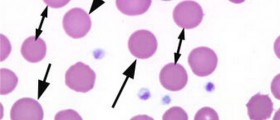Since the human body is susceptible to many diseases despite its natural defense system (the immune system), there are many ways by means of which diseases can be detected and discovered. One of the most reliable methods is blood tests.
There are many kinds of blood tests. One of the most common blood tests is called the CBC blood test. This test measures certain components of the blood, such as red blood cells, white blood cells, platelets, and hemoglobin. Furthermore, the CBC test also examines mean corpuscular volume - MCV, mean corpuscular hemoglobin, and mean corpuscular hemoglobin concentration.

Mean Corpuscular Volume - MCV Blood Test
Mean corpuscular volume blood test measures the average volume of size of the individual red blood cells and is a part of the CBC test. The red blood cells are also called erythrocytes. The measurement unit used in this type of blood test is a femtoliter.
The result of the mean corpuscular volume blood test is obtained when hematocrit is divided by the count of the red blood cells into millions/microliters of blood and then multiplied by ten. Hematocrit is obtained by a test that measures the percentage of blood volume taken up by erythrocytes.
MCV blood test is used to discover whether there are any ailments or blood disorders. When the level of MCV is below or above the normal range, it means that the person suffers from a certain disease although there are hardly any symptoms.
Normal MCV Levels
The normal level of mean corpuscular volume in the blood of a healthy person is between 80 and 100 femtoliters. When the level of MCV is higher than 100 femtoliters, then the person has macrocytic red blood cells, which means that the erythrocytes are larger than the normal size.
On the other side, when the MCV blood test shows the values of mean corpuscular volume in the blood under 80 femtoliters, it means that the red blood cells are microcytic, or smaller than normal size.
The role of the erythrocytes is very important since they contain hemoglobin that carries the oxygen from the lungs to the cells and tissues throughout the body.
When there is a low count of red blood cells, the person suffers from anemia, while high levels of MCV indicate that there is vitamin B12 insufficiency and folic acid insufficiency, as well as hemolytic anemia and pernicious anemia. Low levels of MCV usually indicate iron deficiency anemia.
- Microcytic anemia is a type of anemia where the average erythrocyte is smaller than normal and much smaller than a leukocyte. On the complete blood count (CBC), its measure is under 80 fL while normal MCV is between 80 to 100 fL. It is commonly seen in chronic iron-deficient anemia, anemia of chronic disease, sideroblastic anemia, and thalassemias but can also occur in other conditions.
- Macrocytic anemia is a type of anemia where the average red blood cell volume is larger than normal. On CBC, its MCV is over 100 fL. Macrocytic anemia further subcategorizes as megaloblastic or non-megaloblastic. Megaloblastic anemia is due to impaired DNA synthesis versus normal DNA synthesis in non-megaloblastic anemia.
- Normocytic anemia is anemia with a low hemoglobin and hematocrit range but MCV in the normal range of 80 to 100 fL. This type of anemia can subclassify as hemolytic and non-hemolytic. Normocytic hemolytic can occur intravascularly and extravascularly and can be due to myriad causes. Other laboratory values on the CBC will further indicate the type of anemia.
- Non-hemolytic normocytic anemias can present in early anemia of chronic disease, early iron deficiency anemia, aplastic anemia, microangiopathic hemolytic anemias, and even certain plasmodial infections.
- Folate deficiency and vitamin B12 deficiencies can affect a wide range of demographics throughout the world due to their acquisition from an unbalanced diet; however, vitamin B12 deficiency tends to appear in patients with vegan diets due to its origin of animal products. Moreover, vitamin B12 deficiency can also occur in malabsorptive diseases, Diphllobathrium latum infection, pernicious anemia, and gastrectomy. Organic acidemias were found to affect 1 in 784 live births in the UK.
- Outside of anemia, MCV along with red blood cell distribution is thought to help determine the risk of cardiovascular events after surgery and/or blood transfusions. Findings are that after surgery and/or blood transfusion, patients with macrocytic anemia or microcytic anemia have a higher risk than patients with normocytic anemia. These values together may help prevent cardiovascular events due to closer monitoring after these procedures.

















Your thoughts on this
Loading...